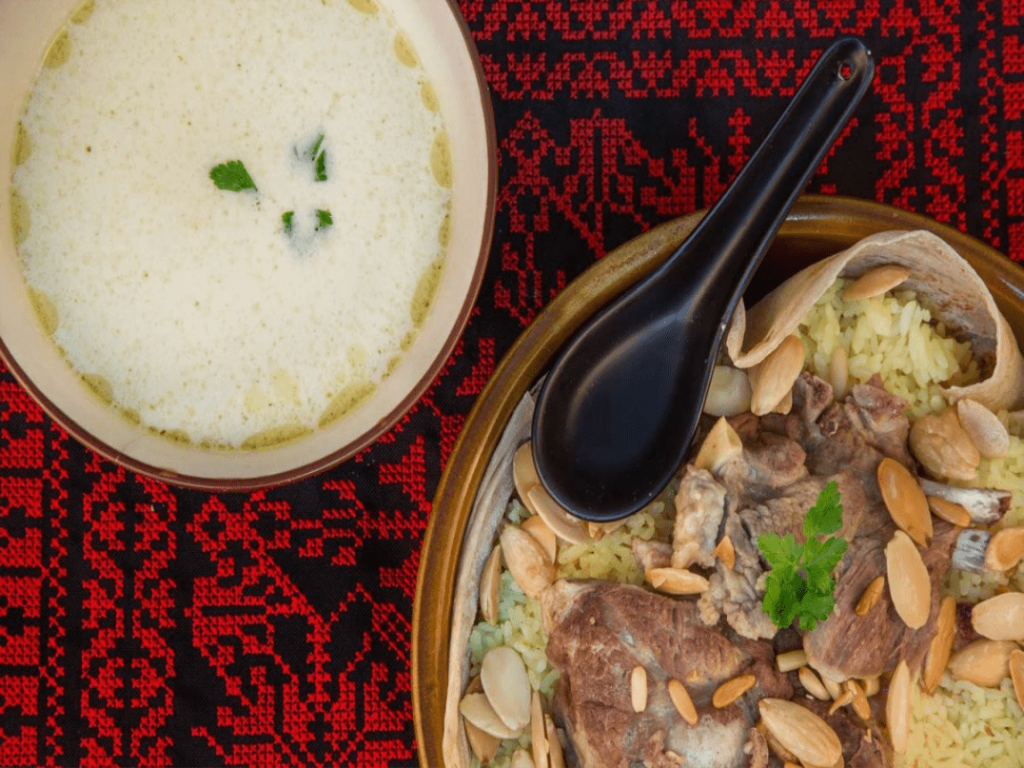For those learning Arabic and eager to experience the authentic flavors of the Arab world, Jordan offers a culinary landscape as welcoming and diverse as its people. From the iconic Mansaf to the refreshing sweetness of Qamar Eddine, Jordan food and drink is an integral part of its culture and a delightful adventure for the senses. If you’re wondering “what food and drink should I try in Jordan” or simply want to know “what to eat in Jordan,” prepare your palate for a journey through the most delicious offerings of this captivating country.
More than just sustenance, Jordan’s food and drinks reflect the Bedouin heritage, the fertile lands, and the warm hospitality that Jordanians are known for. Sharing meals is a central part of social life, and you’ll often find yourself invited to partake in generous feasts. So, get ready to discover the must-try tastes of Jordan!
A Feast for the Senses: Must-Try Jordan Food
Jordanian cuisine boasts a rich array of dishes that will tantalize your taste buds:
- Mansaf (منسف): Arguably the national dish of Jordan, Mansaf is a must-try. It features tender lamb cooked in a fermented dried yogurt sauce called jameed (جميد), served over a bed of rice and thin shrak bread. Often garnished with roasted almonds and pine nuts, Mansaf is a flavorful and culturally significant dish, traditionally eaten communally.
- Maqluba (مقلوبة): Meaning “upside-down,” Maqluba is a delicious rice dish layered with fried vegetables (like eggplant, cauliflower, and potatoes) and meat (usually chicken or lamb), then flipped onto a serving platter. The aromatic spices infuse every bite.
- Kabsa (كبسة): A fragrant mixed rice dish with meat (chicken, lamb, or beef), vegetables, and a blend of aromatic spices like cardamom, cloves, and cinnamon. While popular across the Arabian Peninsula, the Jordanian version has its own unique touch.
- Sayyadiyeh (صيادية): A flavorful dish of spiced rice cooked with fish (often white fish like cod or snapper), and often garnished with caramelized onions and nuts. This dish showcases Jordan’s proximity to the sea (through Aqaba).
- Kofta bi Tahiniyeh (كفتة بالطحينية): Ground meat (usually lamb or beef) mixed with spices, formed into patties or fingers, and baked or grilled, then smothered in a creamy tahini sauce with lemon juice and garlic.
- Mezze (مزة): A delightful array of small dishes served as appetizers, perfect for sharing and experiencing a variety of Jordanian flavors. Must-try mezze include:
- Hummus (حمص): Creamy mashed chickpeas blended with tahini, lemon juice, and garlic, drizzled with olive oil.
- Mutabbal (متبل): Roasted eggplant mashed and mixed with tahini, lemon juice, and garlic.
- Baba Ghanoush (بابا غنوج): Similar to mutabbal but often with a smokier flavor and sometimes including vegetables like bell peppers.
- Tabbouleh (تبولة): A refreshing salad of finely chopped parsley, tomatoes, onions, and bulgur, dressed with lemon juice and olive oil.
- Fattoush (فتوش): A vibrant salad of mixed greens, tomatoes, cucumbers, radishes, and toasted or fried pita bread pieces, dressed with a tangy sumac vinaigrette.
- Falafel (فلافل): Deep-fried chickpea patties, often served with tahini sauce and pickles.
- Stews and Soups:
- Shorbat Adas (شوربة عدس): A hearty and nutritious lentil soup, often seasoned with cumin and lemon.
- Molokhia (ملوخية): A unique stew made from the leaves of the jute plant, often cooked with chicken or lamb and served with rice. Its texture can be slightly slimy but the flavor is distinct and beloved by many Jordanians.
- Street Food:
- Shawarma (شاورما): Thinly sliced marinated meat (chicken, beef or lamb) roasted on a vertical spit and served in a pita bread with various toppings and sauces.
- Falafel Sandwiches: Crispy falafel balls served in pita bread with tahini, pickles, tomatoes, and lettuce.
- Kunafeh (كنافة): While a dessert, the cheesy and sweet kunafeh, especially the Nabulsiyeh variety, is often enjoyed as a quick and satisfying treat from street vendors.
Quenching Your Thirst: Must-Try Jordanian Drinks:
To complement the delicious Jordan food, be sure to try some of the local beverages:
- Arabic Coffee (قهوة عربية – qahwa ‘arabiyya): A strong, bitter coffee flavored with cardamom, traditionally served in small, handleless cups as a sign of hospitality.
- Bedouin Tea (شاي بدوي – shāy badawī): A strong, sweet black tea often brewed with herbs like sage or mint, reflecting the desert traditions.
- Mint Tea (شاي بالنعناع – shāy bil-na’na’): A refreshing and popular tea made with fresh mint leaves.
- Qamar Eddine (قمر الدين): A thick, sweet drink made from dried apricot paste, often enjoyed during Ramadan.
- Jallab (جلاب): A refreshing drink made from date molasses, rosewater, and smoked incense flavor, often served with pine nuts and raisins.
- Tamar Hindi (تمر هندي): A sweet and sour drink made from tamarind pulp.
- Lemon Mint Juice (عصير ليمون بالنعناع – ʿaṣīr laymūn bil-na’na’): A classic Middle Eastern cooler
So, whether you’re savoring the communal joy of Mansaf, indulging in the flavorful Mezze, or sipping on a fragrant Jordanian drink, the culinary landscape of Jordan offers a truly enriching experience. We encourage you to seek out these incredible tastes and allow the food and drink of Jordan to further connect you with its vibrant culture and the warmth of its people.
By the way, before we go, we just want to say that if you liked this article and would like to know more about Jordanian culture or Arab culture in general, or if you’re interested to learn Arabic language skills in the Levantine Arabic dialect, why not head over to our website and download the Kaleela Arabic learning app? As you may already know, researchers have proven that the best way to learn Arabic is through Arabic learning apps. So, start learning Palestinian-Jordanian Arabic now by downloading the Kaleela Arabic learning app to your IOS or Android device today.



